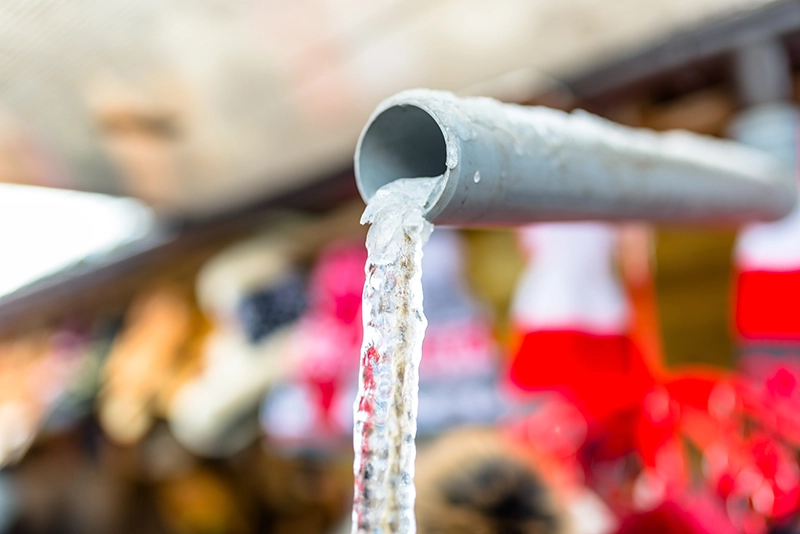How to Tell If Pipes Are Frozen: Key Indicators
Home /
Just last week, while I was grabbing coffee at Hyperion downtown, I overheard a conversation that stopped me in my tracks. A local homeowner was describing how they discovered their pipes were frozen—but only after water started pouring through their ceiling. As plumbing experts serving Fredericksburg, VA, families, we at Clog Heroes know how to tell if pipes are frozen before catastrophe strikes, and we’re sharing these crucial warning signs with our community.
The Silent Threat in Virginia Homes
Remember the brutal cold snap that hit us last February? Over thirty local families faced devastating water damage from burst pipes. The kicker? Most of them noticed little signs days before but didn’t recognize what they were seeing. Here in Fredericksburg, where temperatures can swing wildly during winter, knowing these signals isn’t just helpful—it’s essential for protecting your home.
Take the historic district, for example. Those beautiful old homes along Caroline Street? Their pipes are especially vulnerable due to less insulation and older construction methods. Last winter, three families on just one block dealt with frozen pipes. We discovered that each home had shown early warning signs that went unnoticed.
How to Tell If Pipes Are Frozen: The Early Warning Signs
- Low Water Pressure: This can be a sign that a pipe is partially frozen.
- Strange Noises: Banging, whistling, or clanking sounds from your pipes can indicate ice formation.
- Frost on Pipes: Visible frost on exposed pipes is a clear indicator of freezing.
Just yesterday, I got an urgent call from a customer over on Charles Street. She’d noticed her bathroom faucet was acting strange—spitting and sputtering instead of flowing smoothly. Furthermore, the water pressure had dropped significantly overnight. When I arrived, I found a partially frozen pipe in her crawl space. Fortunately, we caught it early enough to prevent any damage.
The thing about frozen pipes is that they don’t just happen without warning. Think of your plumbing system like your body—when something’s wrong, it sends signals. Moreover, catching these signals early can mean the difference between a quick fix and a flooded home.
The Visual Clues That Saved My Neighbor’s Home
Walking through unheated spaces in your home? Run your hand along exposed pipes. Last winter, my neighbor Tom felt frost on his basement pipes during our weekly card game. Additionally, we spotted condensation forming in unusual patterns. Therefore, we took immediate action, potentially saving him thousands in repair costs.
Reading Your Home’s Warning Signals
Your home speaks to you too. Moreover, those weird whistling sounds from your pipes? They’re not just random noises. Furthermore, that hollow knocking when you run the dishwasher? These sounds are trying to tell you something important about how to tell if pipes are frozen.
I’ve heard every sound a pipe can make—from the subtle ticking of expanding metal to the ominous gurgling of trapped air. Each sound tells a story. Learning to interpret these sounds could save your home from serious damage.
Understanding Water Flow Patterns
Have you ever turned on your kitchen faucet only to get a weak trickle? A customer from Fall Hill Avenue experienced this last December. Furthermore, these subtle changes signaled a bigger problem brewing within her walls.
The tricky part about water pressure issues is that they can be deceiving. Sometimes, you’ll have full pressure in one bathroom while another barely drips. Therefore, it’s crucial to check all your faucets, especially during cold snaps.
The Temperature Danger Zones: How to Tell If Pipes Are Frozen
Living in Fredericksburg means dealing with unpredictable winter weather. Remember that week last January when temperatures dropped from 55°F to 15°F overnight? Consequently, our emergency line lit up like a Christmas tree. Understanding your home’s vulnerable areas becomes crucial when temperatures plummet below 20°F.
Let’s talk about those vulnerable spots. Ever notice how the pipes under your kitchen sink feel colder than others? That’s because exterior walls are particularly susceptible to freezing. Additionally, crawl spaces, attics, and garages need extra attention during cold snaps.
Common Misconceptions About Frozen Pipes
You wouldn’t believe some of the myths I’ve heard about frozen pipes. “Running hot water will instantly thaw them”—that’s a dangerous one I heard at the hardware store last week. Another common misconception is that only old homes are at risk. In reality, new constructions can also face frozen pipe issues if they are not properly insulated and protected.
The Steps That Save Homes
When you spot these warning signs, quick action matters. Last month, a customer on Lafayette Boulevard noticed their pipes making strange sounds. Subsequently, they opened all their cabinet doors, allowing warmer air to circulate around the pipes and prevent freezing. They also kept their faucets dripping. Furthermore, their quick thinking prevented a potential disaster.
Prevention starts with awareness. Keep those pipes warm—whether it’s adding insulation or letting faucets drip during freezing nights. Additionally, knowing your main water shutoff valve location can save precious minutes in an emergency.
Professional Solutions That Work
Throughout my years serving Fredericksburg families, I’ve seen how much difference early intervention makes. Learning how to tell if pipes are frozen has saved countless local homes from severe water damage. Therefore, don’t hesitate to reach out when something seems off. Our team at Clog Heroes stands ready to help 24/7.
Got that nagging feeling something’s not right with your pipes? Trust your instincts. Call us at (540)518-2564. We’re your neighbors here in Fredericksburg, and we’ll be there when you need us most.

